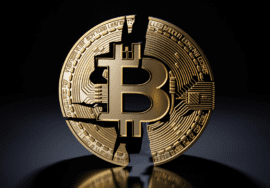

Bitcoin’s long journey towards the mainstream


Opinion by arsim@thejournalbiz.com
Bitcoin’s ’relief rally’ is finally here. After a prolonged deliberation and much controversy in the markets throughout the year, the US Securities and Exchange Commission came with the announcement that Bitcoin desperately needed. We all know the verdict today, as bitcoin is being traded as an ETF by registered funds that already declared the asset in their balance sheet.
However, the primary vision of bitcoin according to the ‘whitepaper’ is that the bitcoin, among other things, is projected to serve as an alternative to mediums of exchange and as such may rival the third parties, as we otherwise know the banking institutions.
To simplify, the purpose of Bitcoin since its inception was pretty straightforward, to be able to serve as a direct payment ( ‘peer to peer’) without the need for extra costs.
Statista on BTC rise and fall (2015-2023)


Statista chart
This means to bypass extra payment, whenever a legal subject makes an international payment via a local bank, which then is backtracked to the central bank and as the final destination ends up at the international bank, to where the transaction is registered initially.
Today, nearly fifteen years after, the bitcoin resembles an asset class we know as gold futures, rather than a digital currency for what it was initially created for.
However, bitcoin went through a consistent existential crisis and had more ups and downs than any asset we can name of. In spite of it all, bitcoin managed to survive, while its value kept rising at the same time. That said, we can also recall the days when it plunged over 50% of its value within a week, making many crypto-enthusiasts turn from a ‘FOMO’ to ‘FUD’ and back to ‘HODL’ pretty fast.
The final nail in the coffin, as the saying goes, is considered to be the latest scandal involving manipulative trades and dodgy schemes, that almost plunged Bitcoin into a point of no return. The recent case involving Sam Bankman Fried, who is currently being tried for fraud and embezzlement through his bankrupt company FTX, reminds us of the terrible pyramid scheme during the 90s, that led tiny European country Albania into chaos, and on the verge of declaring bankruptcy.
However, Bitcoin’s resistance right at the height of the global crisis during the isolation from the pandemic signaled that this game is played ‘long’. Amid the unprecedented crisis we all witnessed, bitcoin soared. On the night of 18th October 2021, for the very first time, bitcoin reached an all-time high and was traded at $66,900 per coin.
Bloomberg chart on BTC bull run during pandemics


Bloomberg chart
On the other hand, bitcoin continued to show its unpredictability in the market and just one year later, more precisely on the 24th of October, 2022, bitcoin lost over 70% of its value and was traded for only $19,200 per 1 BTC, and this continues to be one of the biggest weaknesses that characterizes this asset.
- As of today, bitcoin has little to very limited use in the international payment sector.
Moreover, no major brand accepts Bitcoin as a means of payment, not only because of the speculation and fluctuation that Bitcoin has among other things, but also due to the usability and security of owning the said asset.
Two years ago, Bloomberg reported that Tesla became the most popular brand to accept Bitcoin as a means of payment. This was obviously fantastic news for all, but Tesla quickly reversed the decision, officially citing “the suspension of Bitcoin is due to climate concerns”.
While Apple, after reconsidering whether or not to accept Bitcoin as a payment option for its products, decides not to accept it until further notice. Being prone to large fluctuations in values and open to speculation can harm any asset, and Bitcoin cannot be an exemption.
The second most important issue is that of security and the preservation of a bitcoin for individual investors. This is because Bitcoin has a specific protocol on how to handle it. The first rule is that the password cannot be changed, and the second rule is that the digital wallet must be installed while properly using a code or private key.
Things can turn from bad to worse for anyone who is overconfident in this field.
As a reference, I’ll indicate the case reported by the Wall Street Journal, where a self-proclaimed innovator, Stefan Thomas, although a software engineer by profession, has officially locked himself out of his 7,000 Bitcoins, (currently worth over 225$ million) because he simply forgot the password of his wallet.
It may seem odd but we may have to reconsider our memory skills before investing in bitcoin.
In the end, amid many twists and turns in and off the field from the crypto space, it’s safe to say that we cannot foresee nor conclude anything that can be taken for granted. Perhaps, the very vision and the future of Bitcoin remain correlated to the anonymity of its creator, the innovator no one knows his whereabouts, literally the biggest living shadow on the earth, Mr. Satoshi Nakamoto.








